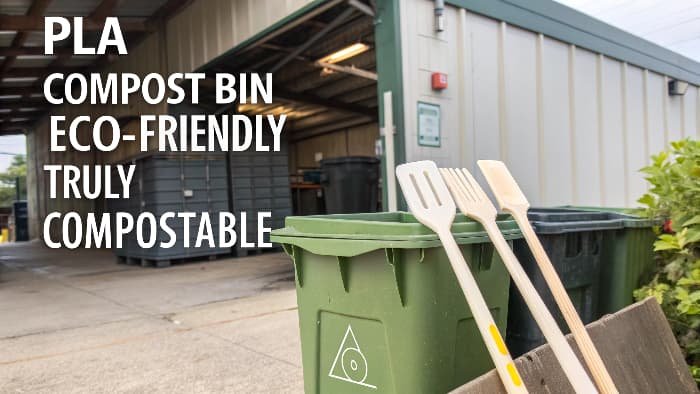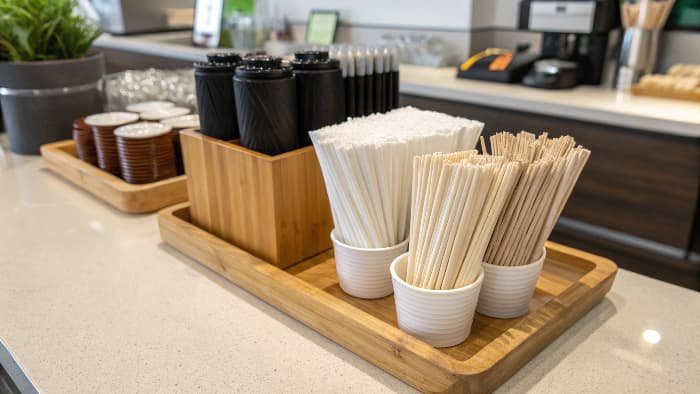Tired of those flimsy plastic stirrers polluting our planet? Looking for a truly green alternative that doesn’t compromise on quality for your cafe or business?
Yes, PLA (Polylactic Acid) coffee stirrers are a leading sustainable option. Made from plant-based resources, they are commercially compostable, offering a significant environmental improvement over traditional plastic.
I’ve seen so many businesses, just like yours, grappling with the plastic problem. It’s a big deal! Especially those little items like stirrers – they add up fast. At Ecosourcecn, we’re always on the lookout for the best eco-solutions, and let me tell you, PLA stirrers are a game-changer. They feel like a step into the future, a future where our daily conveniences don’t have to cost the Earth. Let’s dive into what makes them so special.
What’s the Deal with PLA Anyway: Is It Really Plant-Based?
You hear "PLA" a lot in eco-friendly circles, but what is it really? Is it some newfangled plastic, or something genuinely different and better for our planet?
PLA stands for Polylactic Acid, a bioplastic derived from renewable resources like corn starch or sugarcane. It’s not traditional plastic; it’s plant-power in disguise!
It’s funny, the first time I heard about PLA, I was a bit skeptical. "Plant-based plastic? Sounds too good to be true!" But then I did my homework, especially when sourcing for Ecosourcecn. And it is pretty amazing. Think about it – instead of drilling for oil, we’re using things that grow! This shift is massive. For someone like Jacky, our eco-conscious packaging specialist in Canada, understanding the source material is the first step in verifying a product’s green credentials. It’s not just about the end product; it’s about the whole lifecycle.
From Field to Stirrer: The Magic of PLA
So, how does a corn cob or a sugarcane stalk turn into a coffee stirrer? It’s a bit like science magic, but totally real!
- Harvesting the Sweet Stuff: It starts with renewable resources. Typically, it’s the starch from field corn (the kind not usually eaten by humans) or the sugar from sugarcane.
- Sugar Rush: This starch or sugar is then converted into dextrose (a type of sugar) through a process called hydrolysis.
- Fermentation Fun: Microorganisms get to work! They ferment this dextrose, producing lactic acid. This is very similar to how yogurt or beer is made – natural processes!
- Building Blocks: The lactic acid is then converted into lactide, which is like a building block molecule.
- Linking Up (Polymerization): These lactide molecules are then linked together in long chains to form Polylactic Acid (PLA) resin. These are usually small pellets.
- Shaping Up: Finally, these PLA pellets are melted and injection-molded into the shape of coffee stirrers – or cups, cutlery, you name it!
What you get is a material that often looks and feels very similar to traditional plastic (like polystyrene or polypropylene) but comes from a completely different, and much greener, origin. It’s a testament to innovation, really – using nature’s own building blocks to create everyday items. It’s a big part of why we at Ecosourcecn champion PLA products.PLA vs. Plastic vs. Wood Stirrers: Which One Stirs Up Less Trouble?
Okay, so PLA is plant-based. But how does it stack up against the old plastic stirrers we all know, or even the wooden ones? Which is the best choice overall?
PLA stirrers generally outperform traditional plastic environmentally and offer a smoother experience than some wooden stirrers, though wood has its own eco-perks.
This is a question I get a lot. Everyone wants to make the best choice, but it can be confusing with all the options out there. "Should I go wood? Is PLA really better than plastic?" The truth is, each has its pros and cons, but when you look at the bigger picture, PLA often comes out on top for many applications, especially when considering the full lifecycle and end-of-life options. Let’s break it down. I always tell Jacky, it’s about balancing functionality, cost, and true environmental impact.
The Stirrer Showdown: A Detailed Look
| Let’s put these three contenders head-to-head across a few key factors. This is the kind of analysis we do at Ecosourcecn to ensure we’re offering truly sustainable solutions. | Feature | Traditional Plastic (PS/PP) | Wooden Stirrers (Birch, Bamboo) | PLA Stirrers |
|---|---|---|---|---|
| Source Material | Fossil Fuels (Oil/Gas) | Renewable (Trees/Bamboo) | Renewable (Corn Starch, Sugarcane) | |
| Carbon Footprint (Production) | High | Lower (can be carbon neutral if sustainably sourced, e.g., FSC certified) | Significantly Lower than Plastic | |
| Biodegradability | Very Slow (hundreds of years), creates microplastics | Yes, naturally biodegradable | Biodegradable under specific conditions (industrial composting) | |
| Compostability | No | Yes (often home compostable) | Yes (industrially compostable, certified) | |
| Feel & Performance | Smooth, can be brittle | Can be slightly rough, may impart taste for some sensitive palates | Smooth, similar to plastic, no taste transfer | |
| Heat Resistance | Can warp/melt with very hot liquids | Good | Good (standard PLA), Excellent (CPLA – a modified PLA) | |
| End-of-Life Issues | Landfill pollution, microplastics | Generally benign if composted | Needs industrial composting; can be problematic in landfill if not managed |
Traditional plastic stirrers? Honestly, they’re a disaster. Made from fossil fuels, they hang around for centuries, breaking into microplastics that pollute our oceans and soil. Wooden stirrers are a good natural option, especially if they’re from FSC-certified sustainable forests and are composted. They break down nicely. However, some people find they can have a slight woody taste or a rougher texture. PLA stirrers offer that smooth, plastic-like feel many are used to, but without the fossil fuel baggage. Their big win is commercial compostability, turning them back into soil components under the right conditions. The key phrase there is "right conditions"—more on that next!
The Green Truth About PLA: Are They Genuinely Compostable and Eco-Friendly?
"Compostable" sounds great, but what does it really mean for PLA stirrers? Are they miracle products, or is there a catch to their green halo?
PLA stirrers are genuinely compostable in industrial facilities. They break down into natural elements, but require specific conditions (heat, moisture, microbes) not typically found in home composts or landfills.

This is probably the most critical part to understand about PLA. It’s not magic. It’s science! And that science requires specific environments to work its eco-magic. When I first started exploring PLA for Ecosourcecn, I spent a lot of time understanding the nuances of its end-of-life. It’s crucial because "greenwashing" is a real concern, and we want to offer solutions that are genuinely better. Jacky, with his environmental science background, is always asking the tough questions about compostability claims, and rightly so!
The Nitty-Gritty of PLA Composting
So, PLA is "commercially compostable" or "industrially compostable." What does that mean?
- Specific Conditions Needed: Industrial composting facilities create the perfect storm for PLA breakdown:
- High Temperatures: Typically 55-70°C (130-160°F).
- Moisture: Optimal humidity levels.
- Microorganisms: A healthy population of microbes that love to munch on PLA.
- Oxygen: Aerobic conditions (plenty of air).
- Certifications Matter: Look for certifications like BPI (Biodegradable Products Institute) in North America or EN 13432 (TÜV Austria OK compost INDUSTRIAL) in Europe. These ensure the product has been tested and proven to break down within a set timeframe (usually 90-180 days) in such a facility, leaving no harmful residues. We only source certified PLA products at Ecosourcecn – it’s a mark of trust.
- What About Home Compost? Standard PLA generally won’t break down effectively in a backyard compost bin. It simply doesn’t get hot enough for long enough. There are some newer, modified PLAs designed for home composting, but they are less common for items like stirrers.
- And Landfill? If PLA ends up in a landfill, it’s not ideal. Landfills are often anaerobic (lacking oxygen), so the PLA might break down very slowly, or worse, contribute to methane production (a potent greenhouse gas) if it does degrade anaerobically alongside organic waste. This is why proper disposal and access to commercial composting facilities are key to unlocking PLA’s full environmental benefits.
- Life Cycle Assessment (LCA): Even with the need for industrial composting, LCAs generally show that PLA has a lower carbon footprint and uses less non-renewable energy in its production compared to petroleum-based plastics. So, from cradle to grave (or ideally, cradle to composter!), it’s a step in the right direction.
It’s about creating the right systems. If your city or business has access to commercial composting, PLA stirrers are a fantastic sustainable choice. It’s a team effort – manufacturers making compostable products, businesses offering them, and consumers (and municipalities) ensuring they get to the right place.What Are the Benefits of Switching to PLA Stirrers for My Business?
Beyond just being "green," what are the tangible advantages for a cafe, restaurant, or any business to make the switch to PLA coffee stirrers?
Switching to PLA stirrers enhances your brand’s eco-image, appeals to conscious consumers, reduces plastic waste, and can differentiate you from competitors still using traditional plastic.

Let’s be honest, as a business owner, you’re always thinking about the bottom line and your brand reputation, right? And that’s perfectly fine! The great news is that with PLA stirrers, doing good for the planet also means doing good for your business. I’ve seen it happen with so many Ecosourcecn clients. It’s not just an expense; it’s an investment. Jacky in Canada, for instance, knows that his eco-conscious brand relies on these tangible commitments to sustainability to connect with his customer base.
More Than Just a Stirrer: A Statement
Switching to PLA stirrers sends a clear message. Here’s how it benefits your business:
- Enhanced Brand Image: In a world increasingly focused on sustainability, using eco-friendly products like PLA stirrers positions your brand as responsible and forward-thinking. Customers notice these details! It shows you care about more than just profit.
- Attracting Eco-Conscious Customers: This is a big one. A growing number of consumers, especially millennials and Gen Z, actively seek out businesses that align with their values. Offering PLA stirrers can be a deciding factor for them choosing your establishment over another. I personally make choices like this all the time!
- Reduced Environmental Footprint: This is the core benefit, of course. By opting for plant-based, compostable stirrers, you’re directly reducing reliance on fossil fuels and cutting down on plastic waste that would otherwise pollute landfills and oceans for centuries. This is a tangible impact you can proudly communicate.
- Competitive Differentiation: If your competitors are still stuck on plastic, PLA stirrers can give you an edge. It’s a visible sign of your commitment to higher standards.
- Employee Pride: Believe it or not, your staff will likely feel better working for a company that makes sustainable choices. It can boost morale and make them prouder brand ambassadors.
- Meeting Regulatory Trends: Many regions are introducing bans or restrictions on single-use plastics. Switching to PLA proactively positions you ahead of these changes.
Think of it – for the small cost difference per stirrer, you’re getting a powerful marketing message, customer loyalty, and the genuine satisfaction of making a better choice for the planet. We at Ecosourcecn have seen clients use this switch as a talking point in their marketing, on social media, and even in-store signage. It’s a simple swap with a surprisingly big impact! 🔥Conclusion
PLA coffee stirrers are a fantastic, sustainable alternative to plastic, offering businesses a way to reduce their environmental impact while appealing to today’s eco-aware consumers.


